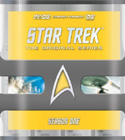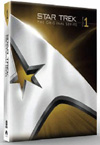The Enemy Within
Star Trek came up with one of its best original concepts for a story here
in this episode, and then milked it for most of its potential. The
central idea of letting the transporter create two versions of Kirk,
each with opposite aspects of his personality, was an excellent way to
use science fiction to explore the human condition. Additionally,
this episode is virtually the template that shows how Star Trek will
approach this central explorative reason for its existence using the
cast of characters that it had finally settled on.
The infamous Kirk-Spock-McCoy trio begins to function as a unit here
for the first time.
Story Mechanics
Early sections of the episode paint a picture of space exploration as
an everyday aspect of life aboard the Enterprise, while the jeopardy
is only shown and known to the audience and to Captain Kirk's log entries
from an unknown future time. A very good way to go in this case.
William Shatner really throws himself into his dual role with a lot of
energy, gusto, and bravery, which goes far to really sell the concept
and make the episode one of early Star Trek's best successes.
There's a nice logic here in starting the episode on the planet,
and using the threat of Sulu and his comrades freezing to death
while waiting for the transporter problems to be worked out. It puts a good
bit of time pressure on the main drama. Of course, fans subsequently
wonder why the Enterprise didn't just send a shuttlecraft down to pick them
up. In production terms, shuttlecraft hadn't yet been thought up.
In story terms, Vonda N. McIntyre fabricated a reason for her novel
of this crew's first coming together... along the lines of the
Enterprise's new shuttles not quite being ready before they had to launch.
It works for me.
So, we get another early episode that takes place mostly on the Enterprise,
which is a new enough environment at this stage that it remains quite interesting.
This time, production design focuses mainly on adding the engine room to its
labyrinth of standing sets for the ship. This room is shot in some unusual ways,
as the script calls for a game of cat and mouse to be played out there,
ensuring that the room gets built and gets showed off a bit. A worthy thing
to do in the fifth episode. Additionally, the sequence becomes something
of a highlight for the episode, both dramatically and musically, and culminates
with the first example of Spock's Vulcan nerve pinch, plus a phaser blast for
added excitement. Awesome.
|
"The Enemy Within" is graced by one of the real standout musical scores of the
first season, with many cues having become extremely familiar to fans
of the show after hearing those cues get used on so many subsequent episodes.
Sol Kaplan here virtually defines the template for scoring the act openings
with quotes of Alexander Courage's main fanfare over shots of the ship
orbiting the planet. We also get many great, inventive action cues
and highly dramatic passionate tension builders, as well as a few
really nice quieter pieces for lighter moods. This score was a very important
ingredient in defining the unique sound that Star Trek's music was later
known for. Magnificent.
|
|
|
The episode quickly cycles through mostly-visual exposition, mystery,
and a good bit of action in its first half. Surprisingly, today's
"villain" is captured and strapped down in sickbay for a good deal of
the second half, yet the drama doesn't suffer at all. We have simply
shifted from doing the obvious action-adventure beats to focusing
on the character questions and philosophical implications, while
Sulu's survival predicament and Scotty's transporter repair efforts
receive their due.
And in fact, this second half features the episode's real gold.
Spock and McCoy get their first really significant debate of the series here,
as they get to examine what has really happened to the Captain,
and what his different halves are like.
Multiple Polarities, headed for Integration
In reality, there are hundreds of different dimensions in anyone's character
that could be polarized and separated for examination - this is virtually
a template for some spiritual "new age" models of what living beings try to
work out as they evolve. This episode's classification of so many traits
in terms of "good" and "evil", each with its own version of Kirk in which to be
embodied, is actually a bit arbitrary. But, I think the definitions here
are still highly useful, and make a good entertaining drama. I'm okay with embracing
this variation, while knowing that many other variations could be equally valid.
Perhaps the main difference is best described as an aggressive and desiring side
versus a calmer and more nebulous side. Interesting is how each side
is shown to contribute to James Kirk as a whole and effective being.
Spock goes to bat for the "dark" side, showing that over here lies the
desired trait of decisiveness, an important pre-requisite for being Captain.
McCoy eventually comes to notice a great strength of Kirk's apparently weaker "nice"
side - the dark version houses most of his fear (and this is important because
fear is a PRIME motivator of darker or undesirable action). Meanwhile, it is
his lighter side that contains his essential bravery and courage. While
Evil Kirk is strapped down in sickbay, Good Kirk gets the material he needs
to showcase his strengths and weaknesses.
Interestingly, some of the newly discovered dualities in quantum physics are
also paralleled here, and these might offer us the most non-judgmental ways
of viewing the character split yet. In many ways, the dark Kirk embodies
the particle, the decisiveness of a chosen form and a path cut off from all others.
Meanwhile, the lighter Kirk expresses the waveform, the endless possibilities
in which any and all things are considered and held of equal value, but in which
one's purpose may get lost or muddled. Thus, "The Enemy Within" remains fascinating
and relevant long after the time in which it was made - passing the test of
truly great art.
Interesting also are the examples, exaggerated in this episode, of Good Kirk
listening to the opposing viewpoints and recommendations from both Spock
and McCoy, while it is up to him to decide what to do. We will see this
trio of characters go through this dynamic on many different subjects
with many different situations, yet here, Good Kirk really struggles
with the decision where the composite whole Kirk would quickly make up
his mind and allow everyone to proceed with their tasks.
And it is to the episode's great credit that the ideal state to strive for
at the end is not to polarize towards the "good" side, but instead to aim
for balance, and to integrate all aspects within oneself. That's a great
and profound statement to make on the human condition, and this episode
does it very, very well. Hats off.
Workplace Friction
If there is one caveat to the episode, it comes through in the subplot
with Yeoman Rand. It is perhaps a questionable move to include such an
overt attack on her by the lead figure of the series, and to portray it
as graphically as they did. On its own, being something few people would
really appreciate seeing, it seems to be dragging the episode's ranking
down a few notches, until later sections of the story work so well to
elevate it back up to classic status. On the other hand, should we
consider it a brave choice for the show to make, demonstrating what the
dark Kirk is capable of and why we should fear him, in ways that
no amount of shouting and brandy drinking could do all on their own?
I think the real test for this scene is in how the situation is dealt with
in the end. The scenes of Rand and Fisher telling the story to Spock and
McCoy feel quite realistic in how they were handled. Indeed, though this is
only Rand's second story in production order, she exhibits a reluctance
in reporting him because she likes and respects the captain, and hindsight
from future episodes tells us she might already have a bit of a crush on him,
which would have been a more interesting thing to explore.
But Star Trek in general needs to aim for a higher ideal.... indeed it has been
convincingly said that one of the great archetypal appeals of the entire
franchise is its depiction of "the ideal workplace", where there is no thought
of discrimination for race or gender, and the work that people do is profound
and important and noble. On that note, I think that going as dark as they did
with Rand's situation demands that it be dealt with a bit better in the final
wrap up. She has something she wants to say to Kirk on the bridge at the end.
Kirk seems a bit too arrogant in assuming that he knows what she is about to say
before cutting her off. I think he'd come off much better if he would be a good
listener instead. Following that, Mr. Spock has a really CHEESY comment to offer her.
That combination is a bit too insensitive to allow this episode to sit as well
with me as it otherwise seemed destined to. If you really want to end on comedy
and implied unspoken desires, it's better to not have gone to quite such an extreme
earlier on. Or, if you do go that dark, then be a bit more sensitive in coming
back into the light. Exactly how comfortable is Rand with her captain after the
fact? How well can we expect them to work together? To what extent does she
prefer to say something to him on a bridge full of people, rather than in private?
I'd have felt much better if he and Spock would have let her express her thoughts
on the matter then and there.
Other minor points of note include the fact that actor Ed Madden returns from
"The Cage", apparently playing the same geologist on the crew, now named
Fisher and sporting a different hair style and uniform. Uhura is heard but not
seen in this episode, while she swaps out her uniform for another of the correct
colour. We also get the
first of McCoy's infamous "He's dead, Jim" lines, this time referring to
the unfortunate little canine creature who also suffers the transporter
splitting effect and can't quite handle the re-integration process.
As a child, I totally bought that this was an alien creature, and even though
it's far more obvious to me now how the creature was achieved, I think it's
still a good low-tech realization. I additionally like the touch of
consistency when the "good" version of the creature shows the same concern and
compassion for his negative alter-ego self as William Shatner does for his own duplicate
- a nice animal acting moment.
Well, Star Trek can largely rack up another very good one as its fifth episode.
Writer Richard Matheson had already become one of the most prolific episode writers
on "The Twilight Zone", and has certainly delivered quite well in what I believe
is his sole contribution to Star Trek. Well done.
Read the next Star Trek review:
"The Man Trap"
|
|



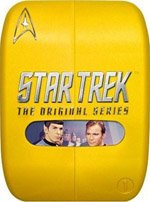
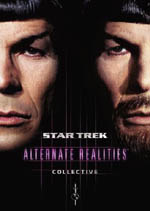


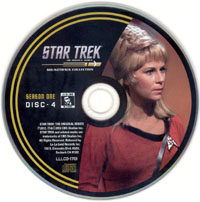
 Region 1, NTSC, U.S.
Region 1, NTSC, U.S. Region 1, NTSC, Canada
Region 1, NTSC, Canada Region 2, PAL, U.K.
Region 2, PAL, U.K.